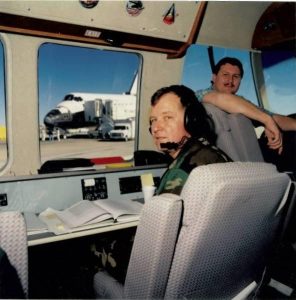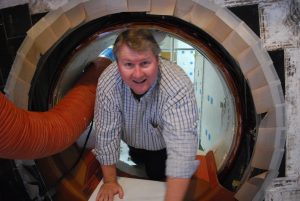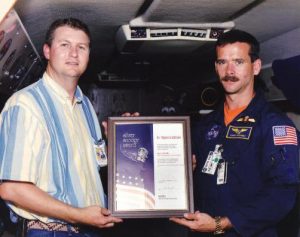George Howard Grimshaw
10-27-1958 | Elida, NM
PROGRAMS:

COMPANIES:
LOCATIONS:
Williams AFB, AZ
Edwards AFB, CA
Mojave Air and Space Port, Mojave, CA
NASA Dryden Flight Research Center, CA
POSITIONS:
USAF Instrument Trainer Specialist - Enlisted Training Instructor
California Air National Guard Avionics Instruments and Systems Technician
Kentron/LTV, Electronics Technician
Flight Systems International, Electronics Technician
Computer Sciences Corporation, Electronics Technician
NASA Dryden Flight Research Center, Avionics Technician
NASA Dryden Flight Research Center, Avionics Branch Chief
NASA Dryden Flight Researech Center, Space Shuttle Landing and Recovery Site Manager
COMMENTS:

George in T-37 Instrument Trainer with Student Pilot
My aerospace career began when I enlisted in the U.S. Air Force in 1977, where I served as a T-37 aircraft simulator instrument flight instructor for undergraduate pilots. I then transferred to the California Air National Guard (ANG) at Van Nuys ANG Base, where I served as a part time Avionics Technician. I also worked at Kentron/LTV as an electronics technician in the Air Force Flight Test Center (AFFTC) Mission Control Center (MCC) at Edwards AFB, CA, supporting DoD flight test and NASA flight research programs including the Space Shuttle. Since the first four shuttle missions were designated as research and development flights, AFFTC Range assets were instrumental in tracking, receiving and processing radar and telemetry data as the shuttle flew over southern California. In preparation for the first Shuttle mission, flight test data from the Space Shuttle Approach and Landing Test program was used to verify the operational readiness of the MCC. In 1980, we moved to the new Ridley MCC at Edwards, where I supported STS-1, 2 and 3.
In 1982, I went to work for Flight Systems International (FSI) at the airport in Mojave, CA, where I supported the flight testing of FSI aircraft. In 1983, I was back at Ridley MCC, working for Computer Sciences Corporation supporting a variety of DoD flight test programs.
In 1984, I went to work as an avionics technician at NASA’s Dryden Flight Research Center. Edwards was still the primary Shuttle landing site and, along with Dryden, opened for guest viewing of Shuttle landings. For 15 years, I supported Shuttle landing and recovery operations as a driver and technician for the NASA Convoy Commander’s (NCC) Vehicle.This vehicle was used during orbiter landing, recovery and towing operations to lead the convoy from the Shuttle Area out to the various concrete and lakebed runway staging sites for Shuttle landings and then back to the Shuttle Area. I also assisted the NCC to ensure he could communicate via radio during convoy operations. Due to the frequency of landings at Edwards, convoy end of mission simulations were held frequently so I learned the ropes of convoy landing and recovery operations.
One mission I remember well is 61-A, Challenger’s last landing at Edwards. Prior to towing the orbiter back to Dryden, we decided to tow Challenger back to the Shuttle Area on the lakebed instead of using a concrete taxiway as we had previously. As we neared the Shuttle Area ramp, Challenger’s tires began to sink into soft sand on the lakebed bringing towing operations to a halt. In order to finish the tow, 1-inch sheets of plywood were brought out to the orbiter and we jacked Challenger’s nose and main gear wheels up and slid a sheet of plywood under them and then placed another sheet in front of each of them. The tow resumed with convoy personnel rotating the sheets of plywood as the orbiter slowly rolled from one sheet to another until it rolled onto the Shuttle Ramp. From then on orbiters landing on the lakebed were towed to Dryden via the concrete taxiway near the main runway.
I was also a member of the convoy team providing AOA support for 51-L mission on January 28, 1986. After verifying we were ready for an AOA landing, we went to the Shuttle office to watch the launch and ascent. As events unfolded, we weren’t sure what had happened. We kept hoping to see the cameras picking up the orbiter heading back to KSC to land. It never did. Once we were released from support, we performed our post ops procedures and went back to our work places. We were devastated to learn of the loss of Challenger and her crew and wondered what the future held for the Shuttle Program. We were thrilled when NASA announced plans for return-to-flight and President Reagan announced that a new orbiter would be added to the Shuttle orbiter fleet.
As we prepared for return to flight (RTF), I led the development of a new NCC Vehicle for Dryden, as well as an air-to ground comm system and installed it at a local Hospital, so emergency room personnel could communicate with inbound helicopters carrying astronauts in the event of a landing contingency at Edwards.
Supporting RTF (STS-26) was memorable, not only because the Shuttle was flying again, but also because Vice President George H.W. Bush came out to watch the landing. On our way to stage the convoy for landing, we had to stop short of the main runway as Air Force 2 landed. After Discovery landed, Vice President Bush, accompanied by California Governor, George Deukmejian came out to greet the crew as they exited the orbiter.
After RTF I continued to support Shuttle landing and recovery operations. And I supported the Landing Systems Research Aircraft (LSRA) Project which used NASA’s CV-990 aircraft as a flying platform to test Shuttle orbiter tires and brakes on the runway surfaces at Edwards and the Shuttle Landing Facility at KSC. Working with LSRA chief pilot, and astronaut Gordon Fullerton, I led the redesign and replacement of the original aircraft manufacturer’s comm system with a system more conducive to a flight test environment.

Inside the new NCC Vehicle with Col. Harry Talbot during STS-49 post-flight operations – Endeavour’s maiden spaceflight
I also researched, tested and proposed the use of a new multi-band air-to-ground/land/ mobile radio to replace the single band transceivers used at Dryden including our Convoy Command Vehicle. After briefing a Shuttle Comm Engineer at KSC, He used these radios to upgrade those used in the comm. kits used at the Shuttle Trans-oceanic abort landing (TAL) sites.
After becoming the Avionics Branch Chief at Dryden, I completed an executive MBA at Embry-Riddle Aeronautical University, Daytona Beach, FL. My EMBA research project was to look at developing an aerospace technician training and certification program similar to the FCC Airframe and Powerplant License. During the course of my research I met Dr. Albert Koller of SpaceTEC, who was already working on such a program. Working with Dr. Koller, we were able to bring the SpaceTEC program to Antelope Valley College in Lancaster, CA. My research also led to a paper I co-wrote titled, “Selling Space: Revitalising Interest in Aerospace Technology Careers.” This paper was published in 2004, inthe inaugural edition of the World Review of Science, Technology and Sustainable Development.
In 2007, I became the Dryden Shuttle Landing and Recovery Site Manager, responsible to ensure Dryden’s readiness to support Shuttle landings, recoveries and turnarounds at Edwards. In this position I supported the last 18 Shuttle missions, 4 of which landed at Edwards (STS-117, 126, 125, 128). I also represented the SSP on the Edwards Runway Refurbishment Project, in which a temporary asphalt runway was built for use while the main concrete runway was demolished and reconstructed. This was significant as all of the Shuttle landing aids, including the microwave landing systems and Ball-Bar, and Precision Approach Path Indicator lighting systems had to be relocated to the asphalt runway, which was shorter and narrower (12,000 feet long and 200 feet wide) than the main runway (15,000 feet long and 300 feet wide).

Egressing Endeavour during STS-126 turn-around operations at Dryden.
On November 30, 2008, the Space Shuttle Endeavour landed on the asphalt runway at the end of STS-126, making it the shortest, narrowest runway and only asphalt runway an orbiter landed on during the life of the SSP. We then moved the landing aids back to the new main runway, which Endeavour, landed on completing STS-125 on May 24, 2009 and Discovery landed on completing STS-128 on September 11, 2009, which was the last landing at Edwards.
Over the years, I also supported multiple semi-annual DoD Shuttle Landing Contingency Exercises held at Edwards, where one or more landing contingency modes were simulated, providing NASA and DoD personnel with valuable training in search and rescue techniques, should a contingency occur during a Shuttle approach/landing. I also ensured that Dryden and Edwards were ready to support Shuttle Training Aircraft flights in which the Shuttle commanders and pilots practiced flying approaches to the various runways.
After the SSP ended, I was the Shuttle Transition and Retirement Project Manager at Dryden leading the effort to ensure all of the Shuttle assets were accounted for and turned over to Dryden for disposition.
To commemorate Dryden’s years of Shuttle support, I compiled/wrote a NASA publication titled, Supporting Shuttle 35+ Years of Excellence at Dryden. It is available online at https://www.nasa.gov/sites/default/files/atoms/files/supporting_shuttle_dryden.pdf

Receiving a Silver Snoopy Award from Astronaut Chris Hadfield
For my years of support and contributions to the Space Shuttle Program, I received the NASA Exceptional Service Medal in 2013, a Space Flight Awareness Award (STS-120) in 2007, and the Astronauts Personal Achievement “Silver Snoopy” Award in 1994, along with numerous other group and team awards.
Following the SSP, I supported the Dream Chaser flight test program at Dryden and the Leading Edge Asynchronous Propeller Technology (LEAPTech) project which is working to develop a small X-Plane demonstrator. I retired from NASA in 2015.
I am a currently a member of Victory Baptist Church, California City, CA, where I am serving on an interim pastoral team for another church. Over the years I have served in various Baptist churches as a pastor, deacon, Sunday School Director and Teacher, and Greeter/Usher.
My wife Theresa (formerly Williams) and I have been married for over 37 years. We have three sons, and two grandchildren.







